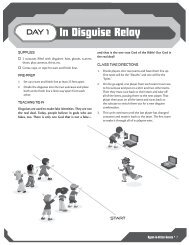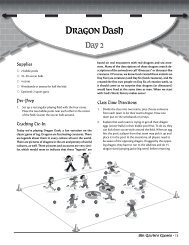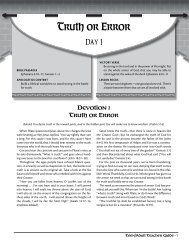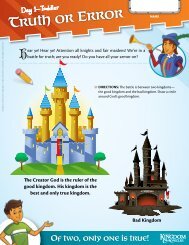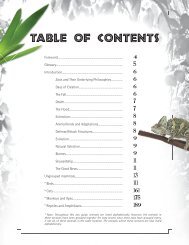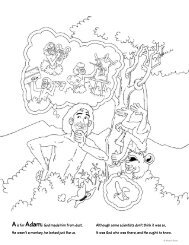The Plant Kingdom - Answers in Genesis
The Plant Kingdom - Answers in Genesis
The Plant Kingdom - Answers in Genesis
You also want an ePaper? Increase the reach of your titles
YUMPU automatically turns print PDFs into web optimized ePapers that Google loves.
<strong>The</strong> 3 rd Day<br />
3<br />
Garden<strong>in</strong>g by Foot<br />
<strong>Plant</strong> comes from an Indo-<br />
European root word<br />
mean<strong>in</strong>g sole of the foot as <strong>in</strong><br />
plant<strong>in</strong>g seeds and<br />
smooth<strong>in</strong>g over the dirt<br />
with your foot. 1 This<br />
method of sow<strong>in</strong>g seed is<br />
suggested <strong>in</strong> Deut. 11:10<br />
<strong>The</strong> <strong>Plant</strong> <strong>K<strong>in</strong>gdom</strong><br />
ach day of the creation account beg<strong>in</strong>s, mysteriously, at night; “and there was<br />
even<strong>in</strong>g and morn<strong>in</strong>g.” This seems contrary to our method of start<strong>in</strong>g the day <strong>in</strong><br />
the morn<strong>in</strong>g and end<strong>in</strong>g <strong>in</strong> the even<strong>in</strong>g, but this is the pattern God established<br />
E<br />
for the creation week and is also reflected <strong>in</strong> the culture He established for the Jews.<br />
1. <strong>The</strong> Bible states that the entire plant k<strong>in</strong>gdom was created <strong>in</strong> a s<strong>in</strong>gle<br />
twenty-four hour period on day three.<br />
2. Although all plants were created on the third day, it appears that the vegetation<br />
<strong>in</strong> the Garden of Eden was await<strong>in</strong>g cultivation by farmer Adam. 2<br />
3. Tall forest trees are the first liv<strong>in</strong>g th<strong>in</strong>gs you can see from space. 3<br />
“…for the land which you<br />
go to possess is not like the<br />
land of Egypt from which<br />
you have come, where you<br />
sowed your seed and<br />
watered it, by foot, as a<br />
vegetable garden…"<br />
4. One out of five liv<strong>in</strong>g organisms are plants. 4<br />
5. Unlike animals, plants make their own food us<strong>in</strong>g sunlight and they<br />
can’t voluntarily move. <strong>The</strong>se are two factors that def<strong>in</strong>e a plant.<br />
6. Botany is the section of biology that deals with plants. It means plant <strong>in</strong> Greek.<br />
7. People who specialize <strong>in</strong> the study of plants are called plant scientists,<br />
though they used to be called botanists.<br />
1 Webster’s New World Dictionary, Second Collegiate Edition p. 1089<br />
2 See <strong>Genesis</strong> 2:5<br />
3 Jonathan Bocknek, <strong>The</strong> Science of <strong>Plant</strong>s. P5<br />
4 Boyce Rensberger, Instant Biology, p. 3<br />
1
Unpronounceables<br />
Tracheophyta is the division<br />
name for all vascular plants<br />
and it is easy to remember<br />
because everyone can relate<br />
to a trachea. What about<br />
the division name for the<br />
nonvascular plants<br />
<strong>The</strong> fact is that scientists<br />
cont<strong>in</strong>ue to change these<br />
names with amaz<strong>in</strong>g<br />
regularity. Even Tracheophyta<br />
is used less <strong>in</strong><br />
many circles.<br />
Classify<strong>in</strong>g <strong>Plant</strong>s<br />
ust as animals and people are categorized as either vertebrates or <strong>in</strong>vertebrates,<br />
so plants are easily categorized as be<strong>in</strong>g either vascular or nonvascular plants.<br />
J<br />
1. <strong>The</strong> plant k<strong>in</strong>gdom has two ma<strong>in</strong> groups: vascular and nonvascular.<br />
2. Vascular plants are <strong>in</strong> a division called Tracheophyta.<br />
3. Tracheophyta comes from the same word we get trachea because they<br />
both refer to hollow tubes to move air and/or water around.<br />
4. Vascular means “a slender tube or vessel.” It’s related to the word vase.<br />
5. Nonvascular plants absorb water through their surfaces.<br />
As of this writ<strong>in</strong>g, scientists<br />
are classify<strong>in</strong>g nonvascular<br />
plants as<br />
Marchantiophyta<br />
Thocerotophyta<br />
Bryophyta<br />
and other<br />
unpronounceable words.<br />
Vascular plants have other<br />
equally confus<strong>in</strong>g names.<br />
We’re stick<strong>in</strong>g with<br />
vascular and nonvascular.<br />
2
Vascular <strong>Plant</strong>s<br />
Vascular <strong>Plant</strong>s<br />
hese are the majority of all plants; plants with a trachea or tubes<br />
for transport<strong>in</strong>g water and nutrients to all the cells of a plant.<br />
T<br />
1. <strong>Plant</strong>s that have seeds hidden <strong>in</strong>side them are called angiosperms, which literally<br />
means “hidden seeds.” 9 out of 10 plants are angiosperms. 5<br />
2. <strong>Genesis</strong> chapter one specifically talks about vascular plants like trees,<br />
herbs and grasses; but all vegetation, or at least the seeds for it, was<br />
created on the third day.<br />
5 . Louise and Richard Spilsbury, <strong>Plant</strong> Classification. P.11<br />
3
Vascular <strong>Plant</strong>s<br />
Achoo!<br />
Allergies are caused from an<br />
immunity system on<br />
overload. Your body<br />
produces antibodies to fight<br />
<strong>in</strong>fections. Allergens are<br />
usually neutral substances,<br />
like pollen or dust.<br />
An allergic overreaction <strong>in</strong> the<br />
nose is what we call hay fever; <strong>in</strong><br />
the lungs it’s called asthma. If<br />
your sk<strong>in</strong> reacts it’s called hives<br />
and <strong>in</strong> your stomach we call it<br />
food allergy. If your whole body<br />
reacts, it’s called anaphylactic<br />
shock and can<br />
be life threaten<strong>in</strong>g.<br />
Juicy Fruit<br />
Succulent or juicy fruits are<br />
brightly colored and moist,<br />
with a fleshy tissue<br />
surround<strong>in</strong>g their seeds.<br />
Oranges are a<br />
great example.<br />
Dry “fruits” have a hard, dry<br />
wall around their seeds, like<br />
nuts, gra<strong>in</strong>s and legumes.<br />
World Records<br />
<strong>The</strong> top five most produced<br />
fruits <strong>in</strong> the world are:<br />
#1 Tomatoes 60 MTY*<br />
#2 Bananas 44 MTY<br />
#3 Apples 36 MTY<br />
#4 Oranges 34 MTY<br />
#5 Watermelons 22 MTY<br />
*MTY=million tons per<br />
year 7<br />
<strong>The</strong> world record for a tomato<br />
is nearly 8 lbs, the weight of a<br />
youth’s bowl<strong>in</strong>g ball.<br />
1. <strong>Plant</strong> Parts<br />
Flowers<br />
A. Flowers are very diverse <strong>in</strong> how they work. <strong>The</strong> ones we described <strong>in</strong><br />
the film are a common and simple type of flower design.<br />
B. Flowers are just one part of the plant. <strong>The</strong>ir function, besides look<strong>in</strong>g<br />
nice to people, is to reproduce the plant. <strong>The</strong>y make and scatter seeds.<br />
Flowers attract poll<strong>in</strong>ators. Birds see reds and yellows while many<br />
<strong>in</strong>sects see the ultraviolet parts of the flower.<br />
C. Two ma<strong>in</strong> parts of a plant are the male Stamen (which has the pollen on it)<br />
and the female Stigma (which is the top of the stalk where the eggs are).<br />
D. Fertilized or poll<strong>in</strong>ated eggs turn <strong>in</strong>to new seeds and the protect<strong>in</strong>g<br />
area becomes fruit.<br />
E. Fruit is generally thought of as oranges and bananas. But fruit really<br />
means the ripen<strong>in</strong>g base that protects the seed. 6<br />
F. A vegetable means the edible part of any plant such as leaves, stems and roots.<br />
G. Vegetative reproduction means start<strong>in</strong>g a plant us<strong>in</strong>g a piece of the plant like a<br />
stem or root or rhizome like Iris flowers. Graft<strong>in</strong>g is another method which<br />
attaches one plant part <strong>in</strong>to another plant<br />
H. Spores are a very different k<strong>in</strong>d of seed that can reproduce a plant all on<br />
their own. Fern leaves have spores on them. Although spore actually means<br />
seed, plant scientists make a clear dist<strong>in</strong>ction between regular seeds<br />
(flower<strong>in</strong>g and cone-bear<strong>in</strong>g plants) and spores (ferns). Thus, spore plants<br />
do not have hidden seeds and thus are not angiosperms.<br />
6 Fruit is technically the ripe ovary of the plant. Ovary is Lat<strong>in</strong> for egg.<br />
7 Source: Furmanos Tomato Corporation www.furmanos.com<br />
4
Vascular <strong>Plant</strong>s<br />
Leaves<br />
A. <strong>Plant</strong>s use sugar <strong>in</strong> the form of glucose, not too much different than<br />
the sugar people like to eat. This is the primary function of leaves; to<br />
manufacture sugar from their environment so the plant can eat.<br />
Little Foot<br />
<strong>The</strong> petiole, the little foot,<br />
will twist and turn so that each<br />
leaf faces the sun for<br />
greatest absorption.<br />
Leaf Blade<br />
<strong>The</strong> blade of a leaf is technically<br />
called the lam<strong>in</strong>a mean<strong>in</strong>g “th<strong>in</strong><br />
or spread out.”<br />
This is also where we get the<br />
word lam<strong>in</strong>ate mean<strong>in</strong>g a th<strong>in</strong><br />
sheet or layer of wood or plastic.<br />
Energy Mach<strong>in</strong>es<br />
<strong>Plant</strong>s only use about 1% of the<br />
entire light spectrum to produce<br />
their food, yet plants produce<br />
billions and billions of tons of<br />
food per year. 8<br />
Fossils exist of giant 99 foot tall<br />
horsetail plants and enormous<br />
fern forests. Fossilized<br />
vegetation has even been found<br />
<strong>in</strong> the polar regions.<br />
It is evident that the climatic<br />
grow<strong>in</strong>g conditions of the past<br />
were far superior to what we<br />
experience today.<br />
Score<br />
Xylem is the technical word for<br />
what we call wood or lumber.<br />
Xylem is pronounced ZIElum,<br />
and it’s an important<br />
word because it starts with the<br />
letter ‘X’ and is worth 28<br />
po<strong>in</strong>ts on a double-word score<br />
<strong>in</strong> a game of Scrabble. ®<br />
B. <strong>The</strong> ma<strong>in</strong> parts of a leaf are the blade and the petiole which means little foot.<br />
C. Some leaves “eat” <strong>in</strong>sects, like sundews and the Venus fly trap.<br />
Actually, the leaves digest the <strong>in</strong>sect and absorb the liquefied material.<br />
D. Photosynthesis is the process whereby leaves make sugar for food.<br />
Here’s the formula:<br />
Carbon dioxide (<strong>in</strong> the air) + water + sunsh<strong>in</strong>e = sugar and oxygen (back <strong>in</strong> the air.)<br />
E. Any extra sugar produced by plants is stored as starch. Potatoes are a<br />
starch storage. Carrots, beets and radishes are a k<strong>in</strong>d of root storage.<br />
F. <strong>The</strong> chemical <strong>in</strong>side each leaf that makes photosynthesis possible is<br />
called chlorophyll. Chlorophyll means green leaf and is responsible for the<br />
green color <strong>in</strong> most plants.<br />
G. Colder weather stops photosynthesis, caus<strong>in</strong>g the brilliant colors<br />
associated with fall to emerge. <strong>The</strong> petiole is cut off from the plant<br />
form<strong>in</strong>g a leaf scar and the leaf falls off.<br />
H. Evergreen needles rema<strong>in</strong> green year around and very slowly<br />
photosynthesize throughout the w<strong>in</strong>ter.<br />
Stems<br />
A. Stems hold the plant up…but you probably already knew that.<br />
B. Stems are the plant’s l<strong>in</strong>k between the water and m<strong>in</strong>erals below the<br />
ground with the light and air above the ground. Water and m<strong>in</strong>erals<br />
are transported through their vascular tissue.<br />
C. Woody stems <strong>in</strong>clude trees, shrubs and v<strong>in</strong>es. In areas where summer<br />
and w<strong>in</strong>ter are present, (as opposed to the tropics for example) trees<br />
will form annual r<strong>in</strong>gs <strong>in</strong>dicat<strong>in</strong>g their age. 9<br />
D. <strong>The</strong>re are also herbaceous stems like grape v<strong>in</strong>es, flowers, beans and<br />
cucumbers. We often th<strong>in</strong>k of herbs as a plant used for medic<strong>in</strong>e. But<br />
technically, any non-woody plant is an herb.<br />
8 A Beka Books. Biology: God’s Liv<strong>in</strong>g Creation. P. 42 and Richard Spilsbury, <strong>Plant</strong> Classification. P. 36<br />
9 Yes, that means that <strong>in</strong> some tropical regions with year round growth, annual tree r<strong>in</strong>gs don’t form.<br />
5
Vascular <strong>Plant</strong>s<br />
Roots<br />
A. Roots anchor a plant to the soil and absorb water & m<strong>in</strong>erals for plant growth.<br />
B. <strong>The</strong>re are two basic k<strong>in</strong>ds of roots: tap roots like carrots and fibrous roots like grass.<br />
Grass Qualifications<br />
A plant qualifies as a grass if<br />
it is self-poll<strong>in</strong>at<strong>in</strong>g, with<br />
long narrow leaves, jo<strong>in</strong>ted<br />
stems, flowers form<strong>in</strong>g <strong>in</strong><br />
small spikes and generally<br />
grow<strong>in</strong>g densely <strong>in</strong> meadows.<br />
Grasses cover nearly 1/3 of<br />
the earth’s land area.<br />
Fast Grass<br />
Bamboo is the tallest grass<br />
grow<strong>in</strong>g over 100 feet tall<br />
with a 3 foot diameter base.<br />
Bamboo is one of the fastest<br />
grow<strong>in</strong>g plants known, with<br />
some varieties grow<strong>in</strong>g 3 feet<br />
per day. 11<br />
2. Grasses<br />
A. Grasses are some of the most important plants <strong>in</strong> the world. All gra<strong>in</strong>s<br />
are grass plants and are usually classified as cereal grasses. <strong>The</strong>y <strong>in</strong>clude<br />
wheat, rice, corn, oats, barley, rye and millet. Columbus called corn,<br />
Indian gra<strong>in</strong>. 350 million tons are produced annually <strong>in</strong> the world. 10<br />
B. Fermented grasses make alcoholic beverages, <strong>in</strong>clud<strong>in</strong>g beer and hard<br />
liquor. W<strong>in</strong>e is made by ferment<strong>in</strong>g grapes.<br />
C. Sugar cane, where we get most of our crystall<strong>in</strong>e sugar, is a grass. Corn is<br />
a grass and so is bamboo.<br />
D. Animals eat forage grass like Timothy grass, fescue, brome, millet, corn,<br />
oat, rye, hay and sorghum grass.<br />
E. Humanity depends on an un<strong>in</strong>terrupted harvest of grass. In develop<strong>in</strong>g<br />
countries, n<strong>in</strong>e out of ten people live almost entirely from grass gra<strong>in</strong>s.<br />
F. Rice feeds over ½ of the world’s population. 12<br />
3. Annuals & Perennials<br />
A. Annuals last only one year. <strong>The</strong>y flower, produce seed and die <strong>in</strong> one season.<br />
<strong>Plant</strong>s like peas, beans , marigolds, sweet peas and z<strong>in</strong>nias are annuals.<br />
B. Perennials come back year after year. <strong>The</strong>y are “permanently<br />
perennial.” Trees, asparagus, asters, black-eyed susans and lavender<br />
are examples of perennials.<br />
Film Trivia<br />
<strong>The</strong> man on the rid<strong>in</strong>g<br />
lawn mower <strong>in</strong> this<br />
segment is John Olson,<br />
Wes’ Father.<br />
C. Biennials are a third group of flower<strong>in</strong>g plants which take two years to<br />
complete their life cycle. In year one, they only form a r<strong>in</strong>g of leaves.<br />
In year two, they produce their flowers and seeds. Cabbage, carrots<br />
and beets are biennials.<br />
10 Augusta Gold<strong>in</strong>. Grass, the Everyth<strong>in</strong>g, Everywhere <strong>Plant</strong>. P 46<br />
11 <strong>The</strong> New Book of Knowledge. Vol. 7 P. 318<br />
12 Augusta Gold<strong>in</strong>. Grass, the Everyth<strong>in</strong>g, Everywhere <strong>Plant</strong>. P 63<br />
6
Vascular <strong>Plant</strong>s<br />
Thirsty Trees<br />
On a sunny day, a s<strong>in</strong>gle<br />
medium-sized oak tree will<br />
give off nearly 150 gallons of<br />
water as the water evaporates<br />
through its leaves. 13<br />
4. Trees<br />
A. Trees are the oldest liv<strong>in</strong>g th<strong>in</strong>gs on the planet. Biblical chronology places<br />
the world-wide flood about 4,500 years ago. <strong>The</strong> oldest trees <strong>in</strong> the<br />
world, bristlecone p<strong>in</strong>es, are 4,500 years old.<br />
B. Some trees, like p<strong>in</strong>e trees, have p<strong>in</strong>e cones where the seeds are<br />
exposed and not enclosed <strong>in</strong> a fruit. <strong>The</strong>se are “gymnosperms”<br />
mean<strong>in</strong>g naked or exposed seeds.<br />
How to Water a Tree<br />
Water<strong>in</strong>g a tree by hos<strong>in</strong>g<br />
down the leaves is like<br />
quench<strong>in</strong>g your thirst by<br />
tak<strong>in</strong>g a shower. Trees,<br />
like most plants, take up<br />
their water through their<br />
extensive root systems.<br />
Water <strong>in</strong> the ground is<br />
water <strong>in</strong> the tree.<br />
C. Trees are the largest liv<strong>in</strong>g th<strong>in</strong>gs on the planet. Some redwoods are<br />
over 350 feet tall.<br />
D. Woody plants that shed leaves and rema<strong>in</strong> leafless <strong>in</strong> w<strong>in</strong>ter are called<br />
deciduous which means “to fall off.” Apple trees are an example.<br />
E. Woody plants that reta<strong>in</strong> leaf coverage throughout the year, like p<strong>in</strong>e<br />
trees, are called evergreens. Sometimes they are called conifers which<br />
means “cone bear<strong>in</strong>g” s<strong>in</strong>ce most conifers are also evergreen trees. Ivy<br />
plants are also evergreens.<br />
Trees are prom<strong>in</strong>ent throughout the<br />
Bible. Two trees were central to the rise and<br />
fall of Adam and Eve. <strong>The</strong> Jews were<br />
forbidden to cut down fruit trees <strong>in</strong> war. 14<br />
Deborah judged Israel under a tree and<br />
Rebekah’s nurse was buried under a tree<br />
named “<strong>The</strong> Oak of Weep<strong>in</strong>g.” Noah’s ark<br />
and the Ark of the Covenant were made<br />
from trees. Jesus Christ died on a tree and<br />
his betrayer, Judas Iscariot, hung himself on a<br />
tree. At the end of time, mank<strong>in</strong>d will at last<br />
have access to the Tree of Life. Trees will be<br />
with us <strong>in</strong> heaven and for all eternity. 15<br />
13 New Book of Knowledge. Volume 18, P 307<br />
14 Deuteronomy 20:19<br />
15 Revelation 22:2<br />
7
Nonvascular <strong>Plant</strong>s<br />
Nonvascular <strong>Plant</strong>s<br />
1. Nonvascular plants <strong>in</strong>clude th<strong>in</strong>gs like algae, moss, fungi, liverworts and mold.<br />
2. <strong>The</strong>re’s a variety of reasons that some biologists won’t classify many of<br />
these organisms as plants: because they have no leaves, flowers, stems<br />
or roots or because some (like fungi) don’t use photosynthesis, or<br />
because their cells have a different material than most plants, etc.<br />
3. Algae are <strong>in</strong> three entirely different k<strong>in</strong>gdoms as of this writ<strong>in</strong>g. Fungi<br />
currently have a k<strong>in</strong>gdom all to themselves. But they were probably<br />
made on day three right along with other plants—“replicat<strong>in</strong>g systems”<br />
that lack the traits associated with animals like voluntary movement and<br />
nephesh life (see page 4 footnote for a description of nephesh).<br />
8
Nonvascular <strong>Plant</strong>s<br />
All about Peat<br />
Peat Moss is the accumulation<br />
of a type of moss called<br />
sphagnum. As the plants die,<br />
new ones grow on top of<br />
them and the dead layers are<br />
packed down <strong>in</strong>to a spongy<br />
mass called peat. Sphagnum is<br />
Greek mean<strong>in</strong>g a k<strong>in</strong>d of moss.<br />
This odd word is pronounced<br />
s-FAG-num. Moss farmers<br />
dra<strong>in</strong> the swamps and use<br />
special mach<strong>in</strong>es to dig it out.<br />
Peat is commonly used as<br />
fertilizer and can be cut <strong>in</strong>to<br />
chunks to burn when other<br />
fuel sources are scarce.<br />
Germany and Canada are the<br />
world’s biggest suppliers of<br />
peat moss.<br />
Warts and Worts<br />
A wart is a small growth on<br />
your sk<strong>in</strong> probably caused<br />
by a virus.<br />
<strong>The</strong> wort of Liverwort and<br />
St. John’s Wort is an obsolete<br />
Old English word that<br />
means plant, vegetable<br />
or herb.<br />
Us<strong>in</strong>g Diatoms<br />
Diatomaceous earth is used<br />
<strong>in</strong> filtration systems because<br />
it is filled with millions of<br />
microscopic pores.<br />
It’s also used as an abrasive<br />
filler <strong>in</strong> toothpaste, as an<br />
absorbent <strong>in</strong> kitty litter and to<br />
help soak up toxic spills.<br />
As a pest killer, diatomaceous<br />
earth causes small cuts <strong>in</strong> the<br />
waxy outer layer of <strong>in</strong>sects,<br />
caus<strong>in</strong>g them to dehydrate<br />
and die.<br />
<strong>The</strong>re is even a food grade<br />
version that kills worms <strong>in</strong><br />
people and pets.<br />
1. Moss & Liverworts<br />
A. Everyone agrees these belong <strong>in</strong> the plant k<strong>in</strong>gdom even though they have<br />
no true leaves, stems, roots or vascular tissues. <strong>The</strong>y use photosynthesis which<br />
gives just about anyth<strong>in</strong>g a free ride to the plant k<strong>in</strong>gdom.<br />
B. Moss is the soft green plant that carpets damp rocks, walls and roofs.<br />
It can act like grass <strong>in</strong> keep<strong>in</strong>g soil erosion down.<br />
C. Liverworts look like clumps of little, dark green leaves. <strong>The</strong>y are a small,<br />
low-grow<strong>in</strong>g plant filled with moisture and green chlorophyll.<br />
2. Algae<br />
A. Algae actually means moldy and putrid which is why algae are often called scum,<br />
because scum is any th<strong>in</strong> layer of impurities that forms on the top of liquids.<br />
B. In the food cha<strong>in</strong>, algae are on the bottom. <strong>The</strong> smallest fish eat algae<br />
and then the bigger fish eat smaller fish.<br />
C. Algae are thickeners <strong>in</strong> many foods <strong>in</strong>clud<strong>in</strong>g mayonnaise, ice cream<br />
and salad dress<strong>in</strong>gs. Scientists call them “produce prote<strong>in</strong>s.”<br />
D. Algae blooms are caused by the rapid reproduction of various algae <strong>in</strong><br />
both fresh and salt water. <strong>The</strong>y can clog filters and poison the water.<br />
E. Classification of algae is often difficult depend<strong>in</strong>g on your classification<br />
system. Today, you can f<strong>in</strong>d various algae scattered throughout<br />
k<strong>in</strong>gdoms Monera, Protista and <strong>Plant</strong>ae.<br />
F. Diatoms are a microscopic algae eaten by many larger life forms. <strong>The</strong>ir<br />
skeletons pile up by the billions and can be harvested as diatomaceous earth.<br />
G. Algae is the plural word as <strong>in</strong> “lots of algae.” It is pronounced al-jee. <strong>The</strong><br />
s<strong>in</strong>gular is alga and it is pronounced al-guh.<br />
9
Nonvascular <strong>Plant</strong>s<br />
3. Fungi<br />
A. Let’s get it straight. Fungus is s<strong>in</strong>gular; “one fungus.” Fungi is the plural<br />
form, “three fungi” and can be said either FUN-jeye or FUN-guy.<br />
St<strong>in</strong>ks and Rusts<br />
St<strong>in</strong>khorns are just what they<br />
sound like, a foul smell<strong>in</strong>g<br />
fungus. Rusts and smuts are a<br />
plant disease attack<strong>in</strong>g gra<strong>in</strong>.<br />
This fungus makes a black<br />
sooty growth that destroys<br />
the crop.<br />
Eat<strong>in</strong>g Fungus<br />
Mushroom is a word some<br />
people use for an edible<br />
fungus and toadstool is used<br />
for the poisonous ones.<br />
Technically only fungi with<br />
the gills under their bells are<br />
called mushrooms.<br />
B. Fungi were homeless parasites; they were never <strong>in</strong>cluded <strong>in</strong> the animal<br />
k<strong>in</strong>gdom and s<strong>in</strong>ce they don’t photosynthesize, some scientists<br />
removed them from the plant k<strong>in</strong>gdom. Generally, these exiled<br />
parasites reside <strong>in</strong> their own fungi k<strong>in</strong>gdom.<br />
C. Fungi <strong>in</strong>clude mold, mildew, puffballs, mushrooms, st<strong>in</strong>khorns,<br />
athlete’s foot, r<strong>in</strong>gworm, rusts and smuts.<br />
D. Some fungi can grow at the astonish<strong>in</strong>g rate of ½ mile per day. 16<br />
E. Mushrooms are fungi and about 1 out of 100 mushrooms are poisonous<br />
to humans.<br />
F. <strong>The</strong> antibiotic penicill<strong>in</strong> is made from a specific mold (named, not<br />
surpris<strong>in</strong>gly, as penicillium).<br />
<strong>The</strong> Nobel Prizes. Alfred Nobel (1833-96) was the man who <strong>in</strong>vented<br />
dynamite us<strong>in</strong>g diatomaceous earth to stabilize the nitroglycer<strong>in</strong>e.<br />
Nobel became a very wealthy man through this <strong>in</strong>vention and at his<br />
death, he left nearly 95% his entire estate (he was unmarried) to the<br />
establishment of five special prizes. <strong>The</strong>y were to be awarded every<br />
year to “those who, dur<strong>in</strong>g the preced<strong>in</strong>g year, shall have conferred the greatest<br />
benefit on mank<strong>in</strong>d.”<br />
This was the start of the famed Nobel Prizes which have been<br />
awarded every year s<strong>in</strong>ce 1901. <strong>The</strong> five categories for the prizes are physics,<br />
chemistry, medic<strong>in</strong>e, literature and peace. <strong>The</strong> one you hear the most about is<br />
the Nobel Peace Prize. Anybody can be nom<strong>in</strong>ated for a Nobel Prize but<br />
nom<strong>in</strong>ees are never publicly announced and they are not supposed to be told<br />
that they were ever even considered for the prize. Plus, the records are sealed<br />
for 50 years to avoid turn<strong>in</strong>g the prize <strong>in</strong>to a popularity contest.<br />
<strong>The</strong> nom<strong>in</strong>ees are voted on by the Norwegian Nobel Committee. <strong>The</strong> w<strong>in</strong>ners<br />
(which are publicly announced) receive a gold medal, a diploma and a sum of<br />
money currently worth about $1.3 million US dollars. Nearly 800 Nobel Prizes<br />
have been awarded s<strong>in</strong>ce the beg<strong>in</strong>n<strong>in</strong>g of this foundation.<br />
16 D.A. Sousa, What is a Fungus P. 16<br />
10
4. Lichen<br />
A. Lichen is an alga and fungus shar<strong>in</strong>g the same room. <strong>The</strong> alga provides<br />
the food for itself and the fungus us<strong>in</strong>g photosynthesis. <strong>The</strong> fungus<br />
supplies the water, m<strong>in</strong>erals and shelter.<br />
B. Some lichen can be eaten when food supplies are scarce.<br />
C. Beatrix Potter was an accomplished scientific illustrator who studied<br />
fungus and lichen (when she wasn’t writ<strong>in</strong>g bunny stories). She loved<br />
to draw mushrooms <strong>in</strong> particular. Her science paper on lichen verified<br />
that it was <strong>in</strong> fact two life forms work<strong>in</strong>g together.<br />
Flopsy, Mopsy and Cottontail. Helen Beatrix Potter (1866-1943)<br />
was the author and illustrator of more than 20 famous children’s<br />
books, the first and most famous be<strong>in</strong>g <strong>The</strong> Tale of Peter Rabbit. She<br />
and her brother Bertram were raised <strong>in</strong> England, mostly by nannies<br />
and governesses. <strong>The</strong> family summer vacations to Scotland opened<br />
her eyes to nature and the animals that would eventually be featured<br />
<strong>in</strong> her stories. As a child, she would often enterta<strong>in</strong> herself with her<br />
real pet animals who <strong>in</strong>cluded two pet rabbits named Benjam<strong>in</strong><br />
Bouncer and Peter Buck, a tea-dr<strong>in</strong>k<strong>in</strong>g hedgehog named Mrs.<br />
Tiggy-w<strong>in</strong>kle, a spaniel dog named Spot, a Berkshire pig named Pig-<br />
Wig and a mouse named Xarifa.<br />
Her first story about Peter Rabbit was an immediate success. She completed<br />
many scientific illustrations for a naturalist named Charles McIntosh and<br />
eventually completed her paper on lichen.<br />
Potter married at 47 but never had any children. In her will, a significant part of<br />
her property—cottages, 15 farms, 4000 acres of land — were given to the<br />
England National Trust to ensure that its beauty could rema<strong>in</strong> unspoiled. Her<br />
legacy is now part of the Lake District National Park <strong>in</strong> England.<br />
11
<strong>Plant</strong>s Quiz<br />
1. <strong>The</strong> primary function of flowers is to<br />
a) Hold the plant upright<br />
b) Feed the plant<br />
c) Reproduce the plant<br />
d) Defend the plant<br />
2. <strong>The</strong> stigma is which part of the plant<br />
a) Male<br />
b) Female<br />
c) Neither<br />
3. “Botany” is a Greek word that means<br />
a) Vascular<br />
b) <strong>Plant</strong><br />
c) Created<br />
d) Bean sprout<br />
4. Why is the stamen considered the male part<br />
a) It carries the eggs<br />
b) It carries the ovary<br />
c) It gets carried away<br />
d) It carries the pollen<br />
e) <strong>The</strong> stamen isn’t the male part.<br />
5. Vegetation was created on which day<br />
a) 1 st<br />
b) 2 nd<br />
c) 3 rd<br />
d) 4 th<br />
e) 5 th<br />
6. <strong>The</strong> botanical function of fruit is<br />
a) To protect the seeds<br />
b) To water the plant<br />
c) To defend the plant<br />
d) To hold the plant up<br />
e) None of the above<br />
7. <strong>The</strong> stalk attach<strong>in</strong>g a leaf to the limb is<br />
called a<br />
a) Stick<br />
b) Lichen<br />
c) Lam<strong>in</strong>a<br />
d) Blade<br />
e) Petiole<br />
8. <strong>The</strong> division name of vascular plants is<br />
a) Tracheophyta<br />
b) Trachea<br />
c) Thallophyta<br />
d) Angiosperm<br />
9. Circle the nonvascular plant<br />
a) Cattail<br />
b) Apple<br />
c) Tulip<br />
d) Moss<br />
10. Chlorophyll is the chemical responsible for<br />
a) Poll<strong>in</strong>at<strong>in</strong>g plants<br />
b) Transport<strong>in</strong>g water <strong>in</strong> plants<br />
c) Photosynthesis <strong>in</strong> plants<br />
d) Purify<strong>in</strong>g water <strong>in</strong> plants<br />
11. <strong>The</strong> formula for photosynthesis is<br />
a) Carbon dioxide + water + sunsh<strong>in</strong>e = sugar<br />
and oxygen<br />
b) Carbon dioxide + salt + sugar = water and<br />
oxygen<br />
c) Carbon monoxide + water + tar = sugar and<br />
oxygen<br />
12. <strong>The</strong> primary function of leaves is<br />
a) To cool the plant down<br />
b) To make food for the plant<br />
c) To reproduce the plant<br />
d) To defend the plant<br />
12
13. Technically, fruit is<br />
a) <strong>The</strong> ripen<strong>in</strong>g base around the seed of<br />
any plant<br />
b) Just stuff like apples and oranges<br />
c) Fruit is not a technical term<br />
14. Which of these is NOT a grass<br />
a) Wheat<br />
b) Rice<br />
c) Alfalfa<br />
d) Corn<br />
e) Ivy<br />
15. 9 out of 10 plants have hidden seeds and<br />
are called<br />
a) Annuals<br />
b) Angiosperms<br />
c) Gymnasiums<br />
d) Algae<br />
e) Nonvascular plants<br />
16. A plant is considered nonvascular when<br />
a) It has small leaves<br />
b) It lacks the trachea-like tubes to<br />
transport water<br />
c) It absorbs water from its roots<br />
d) It spreads to other organisms<br />
17. Diatoms were once liv<strong>in</strong>g creatures.<br />
a) True<br />
b) False<br />
18. Penicill<strong>in</strong> is an antibiotic made from<br />
a) Photosynthesis<br />
b) P<strong>in</strong>econes<br />
c) Fungus mold<br />
d) Smuts<br />
19. Lichen is a k<strong>in</strong>d of<br />
a) Nonvascular plant<br />
b) Vascular plant<br />
c) Creep<strong>in</strong>g ivy<br />
d) Perennial grass<br />
e) None of the above<br />
20. A perennial is a plant that comes back year<br />
after year.<br />
a) True<br />
b) False<br />
21. Which of these is NOT a part of a plant<br />
a) Stem<br />
b) Flower<br />
c) Root<br />
d) Lard<br />
e) Leaf<br />
22. Fungi don’t use photosynthesis to make<br />
their food.<br />
a) True<br />
b) False<br />
23. “Conifer” means<br />
a) With seed<br />
b) With fur<br />
c) Hidden seeds<br />
d) Cone bear<strong>in</strong>g<br />
e) None of the above<br />
24. Two of the ma<strong>in</strong> features that def<strong>in</strong>e a<br />
plant are:<br />
a) <strong>The</strong>y make their own food and they<br />
can’t move voluntarily<br />
b) <strong>The</strong>y are yellow and eaten by other<br />
animals<br />
c) <strong>The</strong>y smell and look nice.<br />
d) <strong>The</strong>y absorb water and oxygen.<br />
.<br />
25. Jesus believed that God made the world<br />
<strong>in</strong> six days.<br />
a) True<br />
b) False<br />
<strong>Answers</strong> are on page 99<br />
13
Possible Discussion Questions<br />
-How is eat<strong>in</strong>g a plant the same or different than eat<strong>in</strong>g an animal<br />
-What did Jesus believe about creation and the Bible Why is it important to<br />
believe what He believed<br />
-How do we know the Bible is a reliable document<br />
-God made all vegetation on the day before He made the sun. How could the<br />
plants have survived this<br />
-Discuss a few of your favorite ways plants are talked about <strong>in</strong> the Bible.<br />
END OF PLANT SEGMENT<br />
14



